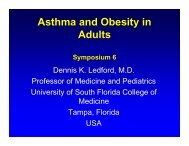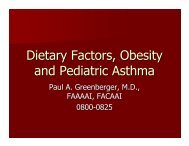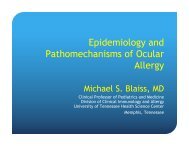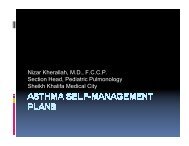Dubai Final-v20.indd - World Allergy Organization
Dubai Final-v20.indd - World Allergy Organization
Dubai Final-v20.indd - World Allergy Organization
Create successful ePaper yourself
Turn your PDF publications into a flip-book with our unique Google optimized e-Paper software.
ABstrACts<br />
ABstrACts<br />
1404<br />
EFFiCaCY oF FEXoFEnaDinE in DiFFErEnT DoSagES For TrEaTmnET oF SEaSonal allErgiC rHiniTiS<br />
Eatemadi, A.<br />
immunology & infectious disease, Ahvaz univrsity of medical siences, Ahvaz, iran.<br />
Background: the aim of this study was to determine the efficacy of fexofenadine in different dosages for treatment of seasonal<br />
allergic rhinitis ( sAr).method: A placebo-controlled, double blind study was conducted in 114 patients with diagnosis of sAr.<br />
they were randomly assigned to received either 60 mg, 120 mg , 180 mg once daily fexofenadine or placebo for one month.<br />
Patients were evaluated by using total symptom score ( tss ) and total nasal score ( tns ) during and at the end of treatment.<br />
results: Fexofenadine 120-180 mg was significantly more effective than placebo for improvement of sAr signs and symptoms.<br />
no statistically significant difference was seen between two dosages ( 120 mg vs. 180 mg ). Conclusion: Once dail 120 mg<br />
fexofenadine is an effective and safe treatment for seasonal allergic rhinitis.<br />
1405<br />
THE moDiFiED SnoT-20 QUESTionnairE: rEPEaTaBiliTY anD aPPliCaBiliTY To rHiniTiS<br />
sami, A. s.<br />
Ent, royal national throat, nose and Ear Hospital, london, United Kingdom.<br />
Background<br />
rhinitis is a clinically prevalent disease, symptomatically characterised by nasal itch, sneezing and difficulty breathing through the<br />
nose. Patients with rhinitis often suffer from associated symptoms related to posterior nasal, sinus and ear disease. Other effects on<br />
the psychological well being are also accountable to rhinitis.<br />
A number of these features are encompassed in disease specific quality of life (Qol) questionnaires. However, the modified snOt-<br />
20 (msnOt-20) questionnaire aims to correspond to the requirements for a complete and comprehensive assessment of rhinitis<br />
and its impact. it uses a six-point scale to identify clinical severity (0=no problem, 5=very severe problem). method<br />
the msnOt-20 questionnaire was evaluated in a pilot study of disease and non-disease and then used to assess the prevalence of<br />
rhinitis and associated features in a community based survey. Following a successful pilot project, 2000 postal questionnaires were<br />
sent to randomly selected adults from the electoral register in Farnborough. Differences in housing, social class and environment<br />
were balanced with repeat questionnaires sent for non-respondents. results<br />
in the pilot study, there were significant differences (p < 0.001) in symptom reporting between rhinitics and non-rhinitics, with<br />
92.67% of the healthy controls responding on all 20 questions either 0=no problem (85.67%) or 1=very mild problems (7%) in<br />
comparison to 42.07 % in the rhinitis group (28.7 % of responses no problem, 13 % very mild problems). A score of 0 or 1 was thus<br />
taken as normal and 2-5 taken as abnormal.<br />
in the community survey in Farnborough, 68% of 1580 evaluable respondents (79.8 % response rate) had a total snOt-20 score of<br />
0-20 (max 100) with 32% scoring 21 + (max 88). there were significant correlations between the rhinitis domain and the 4 other<br />
domains (paranasal [sinus and ear], sleep, social and emotional). the repeatability of these responses was evaluated in a follow-up<br />
evaluation in a subpopulation. Conclusion<br />
msnOt-20 questionnaire is a disease-related Qol rhinitis questionnaire, which is valid for the evaluation of rhinitis and the impact<br />
of disease on quality of life. it identified a high prevalence of nasal and paranasal problems within the community with significant<br />
co-morbidity caused by rhinitis.<br />
1406<br />
a CommUniTY BaSED SUrVEY on THE PrEValEnCE oF rHiniTiS<br />
sami, A. s.<br />
Ent, royal national throat, nose and Ear Hospital, london, United Kingdom.<br />
Background<br />
rhinitis is an increasingly common condition although there is limited information as to its true prevalence within the community.<br />
this study aimed to obtain a current prevalence of rhinitis within the community and to explore its impact on social and emotional<br />
functioning. A survey of 2000 adults in the Farnborough area was devised and carried out using the modified snOt-20 (msnOt-20)<br />
questionnaire for this study.<br />
method<br />
A postal survey of rhinitis was conducted in the Farnborough area with 2000 msnOt-20 questionnaires being sent to randomly<br />
www.worldallergy.org 114<br />
FinAl PrOgrAm

















